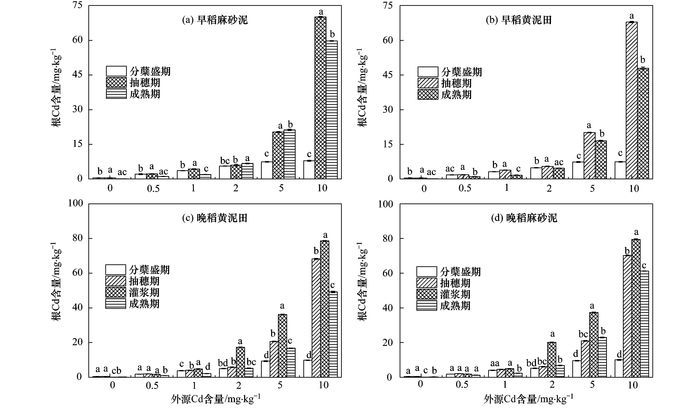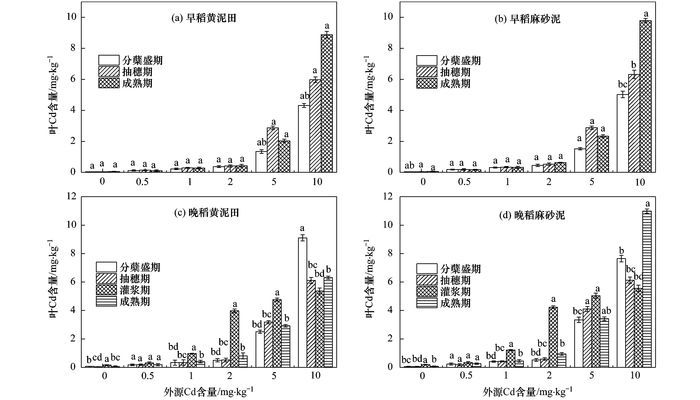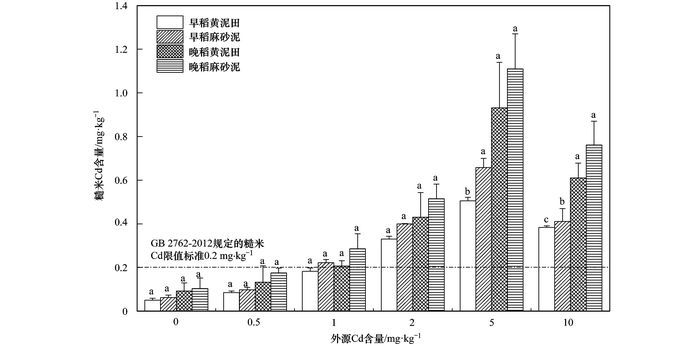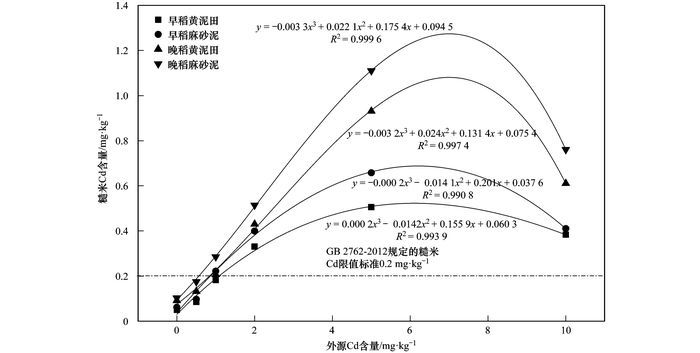2. 长沙县黄兴镇农业综合服务中心, 长沙 410100
2. Agricultural Integrated Service Center of Huangxing Town, Changsha 410100, China
工农业及城市化的快速发展加速了土壤和环境中Cd的污染程度[1].水稻是我国第一大粮食作物, 而Cd是一种极具生物毒性的重金属元素, 作为有色金属之乡的湖南已经广泛关注水稻土Cd的危害[2, 3].由于土壤Cd污染不仅造成稻米品质下降, 影响我国农业的可持续发展, 还能通过食物链累积, 危害人身健康[4].多年来, 国内外进行了大量的土壤-水稻体系中Cd的迁移研究, 水稻品种、土壤类型对重金属的累积存在较大差异[5~10].甘国娟[11]的研究表明不同母质土壤-水稻系统Cd的迁移系数、积累系数存在明显差异.成颜君等[12]、赵步洪等[13]的研究表明不同母质类型土壤水稻糙米对Cd的累积大于水稻品种基因型. Ding等[14]和Sun等[15]的研究表明不同土壤Cd阈值有所不同.因此关注典型成土母质稻田土壤的Cd污染尤为重要, 不同土壤对Cd吸收累积差异以及土壤重金属Cd安全阈值是一项重要研究内容.本文通过盆栽试验方法研究湖南两种典型成土母质水稻土双季稻Cd吸收累积差异, 推算水稻土Cd安全阈值, 以期为土壤环境质量评价与污染修复控制提供参考依据.
1 材料与方法 1.1 供试材料供试土壤黄泥田为板页岩母质发育的水稻土, 采自长沙县路口镇燕窝屋(地理坐标:北纬28°26′46″, 东经113°19′13″); 供试土壤麻砂泥为花岗岩母质发育的水稻土, 采自长沙县金井镇脱甲村(地理坐标:北纬28°33′31″, 东经113°20′5″).两种土壤均取自耕作层(0~15 cm), 土壤采回后, 捡出肉眼可见的石粒、根系碎屑等杂物, 经风干、研磨后混合均匀备用.两种土壤的基本理化性质如表 1所示.
|
|
表 1 供试土壤基本理化性质 Table 1 Basic physical and chemical properties of soil |
1.2 试验设计
盆栽试验用具为无盖圆形胶质盆, 高20 cm, 桶底半径10 cm.每盆装土4.0 kg.加入CdCl2溶液, Cd水平为:0、0.5、1.0、2.0、5.0、10.0 mg·kg-1(以下图表中均用0、0.5、1、2、5、10表示), 平衡老化30 d.按N 0.15 g·kg-1, P2O5 0.1 g·kg-1, K2O 0.15 g·kg-1, 以尿素[CO(NH2)2]、磷酸铵[(NH4)3PO4]和碳酸钾(K2CO3)的水溶液加入作基肥.
早晚稻盆栽试验分别进行.供试水稻品种早稻为湘早籼45号, 晚稻为湘晚籼13号.每盆种植水稻2穴, 每穴2株, 按大田处理要求进行施肥, 整个生育期保持田面水层2 cm, 每个处理设5个重复.早稻于2016年5月25日移栽, 7月15日收获; 晚稻于2016年7月15日移栽, 10月9日收获.
1.3 采样与分析本试验采用破坏性取样法(即采集整盆全部样品).早稻分别于分蘖盛期(5月25日)、抽穗期(6月10日)、成熟期(7月15日); 晚稻分别于分蘖盛期(8月10日)、抽穗期(9月10日)、灌浆期(9月25日)、成熟期(10月9日)采集水稻全株与土样.去离子水洗净植物后分离根、茎、叶、谷壳与糙米, 并于105℃杀青30 min后, 70℃烘干至恒重, 然后磨碎、过70目筛、称量, 备用.土样自然风干, 磨碎, 过10目筛用于pH值、可提取态重金属浓度测定; 过100目筛用于土壤总重金属测定.
样品分析:土壤理化性质采用常规分析方法测定[16]; 土壤有效态Cd采用DTPA浸提法测定[17]; 土壤总Cd采用王水-高氯酸混酸消解, 火焰原子吸收分光光度法测定[17].植物样品Cd采用干灰化法消解, 石墨炉原子吸收分光光度法测定[17].为保证数据的可靠性和稳定性, 植株Cd含量测定时每个样测3次, 并以国家标准植物样品GSB-23(湖南大米)进行质量控制, 相对标准偏差(RSD)低于5%.
1.4 数据分析本试验中的数据结果采用显著性F测验和Duncan多重比较法(P<0.05)进行统计分析, 应用Excel 2016、SPSS 22.0和Origin 9.0进行处理.
2 结果与分析 2.1 水稻生育期土壤有效态Cd变化水稻各生育期土壤有效态Cd含量测定结果表明, 黄泥田Cd胁迫处理早稻土壤有效态Cd含量在0.15~3.81 mg·kg-1, 平均含量1.16 mg·kg-1, 晚稻土壤有效态Cd含量在0.20~7.29 mg·kg-1, 平均含量1.67 mg·kg-1, 黄泥田早晚稻平均1.45 mg·kg-1; 麻砂泥Cd胁迫处理早稻土壤有效态Cd含量在0.10~3.36 mg·kg-1, 平均含量0.98 mg·kg-1, 晚稻土壤有效态Cd含量在0.13~5.22 mg·kg-1, 平均含量1.34 mg·kg-1, 麻砂泥早晚稻平均1.19 mg·kg-1.晚稻土壤有效态Cd大于早稻; 黄泥田土壤有效态Cd均大于麻砂泥.
随着水稻生育期的延长, 土壤有效态Cd含量呈持续降低趋势, 并从分蘖盛期到抽穗期下降最多, 该趋势在高浓度添加Cd条件下更明显(图 1); 同时, 随着外源Cd含量的增加, 双季稻各生育期土壤有效态Cd含量提高, 土壤有效态Cd含量均与外源Cd含量呈极显著相关关系(P<0.01).相比麻砂泥, 黄泥田土壤有效态Cd含量提高更多, 表现出显著差异(P<0.05);当外源Cd含量相同时, 各时期晚稻土壤有效态Cd大于早稻, 黄泥田大于麻砂泥, 其差异性均达到显著水平(P<0.05).

|
不同小写字母表示同一母质相同Cd水平不同生育期土壤有效态Cd含量差异显著(P<0.05) 图 1 水稻各生育期土壤有效态Cd含量变化 Fig. 1 Change of available Cd in the soil at different growth stages of rice |
从图 2可以看出, 水稻各生育期中, 早、晚稻根部Cd含量在分蘖盛期不高, 在抽穗、灌浆期迅速上升, 达到最高并随后降低; 茎部Cd含量在分蘖盛期处于较高水平, 并在抽穗期有所下降, 到灌浆期达到最高, 之后在成熟期Cd又明显下降(图 3), 可见根、茎、叶中Cd含量受生育期变化影响明显.此外, 不同土壤和不同季度下生长的水稻根、茎部Cd的累积特征有所不同, 表现为晚稻高于早稻, 麻砂泥高于黄泥田, 且差异均达到显著水平(P<0.05).水稻叶部对Cd的累积特征基本与根、茎一致(图 4), 表现为随生育期增延长Cd含量呈增加的趋势, 并在灌浆期达到最高, 成熟期下降.高水平外源Cd下该趋势更明显.不同母质与不同季度条件下, 叶对Cd的累积存在差异, 不同母质发育土壤上晚稻叶部Cd含量在各生育期均显著高于早稻; 麻砂泥发育下的水稻叶部Cd含量亦高于黄泥田.

|
不同小写字母表示同一母质相同Cd水平不同生育期土壤根部Cd含量差异显著(P<0.05) 图 2 水稻各生育期根Cd含量的变化 Fig. 2 Change of the concentration of Cd in roots at different growth stages of rice |

|
不同小写字母表示同一母质相同Cd水平不同生育期土壤茎部Cd含量差异显著(P<0.05) 图 3 水稻各生育期茎Cd含量的变化 Fig. 3 Change of the concentration of Cd in stems at different growth stages of rice |

|
不同小写字母表示同一母质相同Cd水平不同生育期土壤叶部Cd含量差异显著(P<0.05) 图 4 水稻各生育期水稻叶Cd含量的变化 Fig. 4 Change of the concentration of Cd in leaves at different growth stages of rice |
从图 5可知, 当外源Cd在0~5 mg·kg-1, 早晚稻糙米Cd含量均表现出随外源Cd含量的增加而上升的趋势.当外源Cd含量为5 mg·kg-1时, 水稻糙米中的Cd含量达到最大值, 而当外源Cd含量为10 mg·kg-1时, 糙米中的Cd比外源Cd含量为5 mg·kg-1时有一定程度的降低.说明低浓度的Cd胁迫有促进水稻生长, 而Cd浓度过高时抑制水稻生长而产生毒害作用.

|
不同小写字母表示同一母质相同Cd水平糙米Cd含量差异显著(P<0.05) 图 5 添加不同浓度Cd对糙米Cd含量的影响 Fig. 5 Effects of different concentrations of Cd on the Cd content in brown rice |
不同季水稻及不同成土母质类型条件下, 水稻糙米对Cd的累积存在显著差异(P<0.05), 表现为晚稻高于早稻, 麻砂泥高于黄泥田.相同Cd处理水平条件下, 外源Cd水平越高差异越明显, 如外源Cd含量为5 mg·kg-1时, 晚稻糙米Cd含量在黄泥田和麻砂泥条件下显著高于早稻, 分别是早稻的2.8倍和1.7倍; 早稻糙米Cd含量在麻砂泥条件下显著高于黄泥田条件下的, 是其1.3倍.
2.4 水稻全株Cd累积量通过测定水稻各部位(根、茎、叶、壳和糙米)Cd含量及干重, 汇总计算出水稻全株Cd累积量(表 2).结果表明:随着水稻生育期的延长, 水稻全株Cd累积量表现出从分蘖盛期到成熟期的持续增加的趋势, 且随外源Cd含量的提高而逐渐增加, 这种趋势在高浓度外源Cd处理下更明显, 这主要是由于根、茎、叶生长率加快以及不断的累积Cd而使得Cd累积量始终保持增加的趋势.水稻全株Cd累积量在不同季水稻及不同母质条件下有所不同, 按不同土壤和早、晚稻统计Cd胁迫处理水稻全株Cd累积量, 早稻平均为1.54 mg·pot-1, 而晚稻为3.04 mg·pot-1, 晚稻大于早稻, 约其2倍; 黄泥田平均为2.04 mg·pot-1, 麻砂泥为2.54 mg·pot-1, 麻砂泥大于黄泥田.
|
|
表 2 水稻全株Cd累积量1)/mg·pot-1 Table 2 Total accumulation of Cd in rice/mg·pot-1 |
2.5 水稻各部位Cd与土壤有效态Cd及外源Cd水平的关系
相关分析结果表明, 不同成土母质双季稻根、茎、叶Cd含量均与土壤有效态Cd及外源Cd水平呈极显著的正相关关系(表 3).早稻外源Cd水平与糙米Cd含量和土壤有效Cd含量的相关系数范围在0.640~0.994之间, 其中与土壤有效Cd含量均呈极显著相关水平(P<0.01), 而Cd水平与糙米中Cd含量相关性不显著.晚稻在不同成土母质条件下, Cd水平与糙米Cd含量和土壤有效Cd含量的相关系数范围在0.699~0.997之间, 其中与土壤有效态Cd含量均达到了极显著相关水平(P<0.01), 麻砂泥条件下土壤重金属Cd有效态含量与糙米中Cd含量达到了显著相关水平(P<0.05), 而外源Cd水平与糙米中Cd含量相关性不显著.
|
|
表 3 水稻各部位Cd含量、有效态Cd含量和外源Cd水平的相关性1) Table 3 Correlation among Cd concentration in rice, the effective concentration of Cd and exogenous Cd addition |
3 讨论 3.1 不同母质土壤水稻对Cd吸收累积差异的原因
一般认为, 土壤-水稻系统Cd的迁移以及糙米Cd累积受pH值、土壤机械组成、黏粒矿物含量、阳离子交换量、有机质、土壤湿度和土壤温度等因素影响[18, 19].土壤淹水, 氧化还原电位(Eh)下降并形成还原环境, 土壤阳离子浓度有所减少, 导致其与Cd的吸附竞争降低; 土壤有机质的积累使水稳定性聚集体更加稳定, 均使得Cd在土壤颗粒上的吸附作用得到促进[20~23].试验结果早稻糙米Cd比晚稻低, 可能与早稻时期降雨量大且土壤温度相对较低有关.土壤温度会影响水稻对Cd的累积, 土壤温度升高, 在Cd的刺激下, 水稻根系土壤的微生物含量、C含量和酶活性增加, 促进了Cd向水稻体内的转运[24].土壤温度升高导致土壤孔隙水pH值降低, 水溶性Cd浓度增加[25], 有利于Cd在水稻植株的迁移累积.
土壤有效态Cd麻砂泥低于黄泥田, 但水稻糙米中Cd高于黄泥田, 可能与黄泥田黏粒含量高有关.麻砂泥土壤颗粒较大, 比表面积小, 因此其吸附Cd的能力较弱[27].两者差异性形成原因可能还与黏粒矿物类型有关[28].花岗岩母质发育而来的麻砂泥土壤黏粒矿物主要是1:1型(高岭土), 而板页岩发育而来的黄泥田土壤黏粒矿物还含有2:1型(云母、伊利石等). 1:1型黏土矿物, 无膨胀性, 带电荷少, 胶体特性差, CEC含量低; 2:1型黏土矿物则带电量较大, CEC含量较1:1型高. CEC反映了土壤胶体的负电荷量, CEC越高, 负电荷越高, 能够提供更多的吸附位点吸附Cd2+, 使土壤对Cd的吸附量增加, 可能导致进入糙米中的Cd含量降低[27~31].供试土壤黄泥田pH值高于麻砂泥, pH值对土壤重金属有效态含量影响显著, pH值越高, 带正电荷的重金属离子被带负电荷的土壤胶体吸附越多、与黏土矿物发生共沉淀的量也越多, 越容易被固定而降低其活性; 同时, pH值越高, 土壤中Fe、Mn等离子形成的羟基化合物为Cd提供了越多的吸附位点, 从而使有效态Cd含量降低, 因此进入糙米中的Cd含量有所降低[32, 33].
3.2 不同母质土壤稻米Cd安全阈值不同成土母质条件下, 通过糙米Cd含量与外源Cd含量的对应关系模拟出Cd累积方程(图 6), 并将国家大米镉限值标准(GB 2762-2012, 0.2 mg·kg-1)代入方程, 得到土壤Cd安全阈值分别为, 早稻:0.98 mg·kg-1(黄泥田)与0.86 mg·kg-1(麻砂泥)以及晚稻:0.83 mg·kg-1(黄泥田)与0.56 mg·kg-1(麻砂泥), 均高于国家标准(HJ 332-2006).范中亮等[34]研究了碱性潮土(pH=7.50)和酸性水稻土(pH=5.94)土壤Cd安全阈值分别为1.49 mg·kg-1和0.79 mg·kg-1; 陈齐等[27]研究得出碱性紫色土(pH=7.70)和酸性红黄泥(pH=5.10)土壤Cd安全阈值分别为6.36 mg·kg-1和3.08 mg·kg-1.对比可知, 碱性土壤Cd安全阈值远高于酸性土壤, 说明pH值是影响土壤Cd阈值的重要因素, 这与李志博等[35]根据稻米Cd的预测模型和稻米摄入风险研究的估算结果一致.进行土壤修复时, 应考虑施加酸碱调节剂调控土壤pH值.因此本研究为湖南稻米Cd限量标准和生态系统健康的土壤Cd安全阈值和大田施用降Cd措施提供了一定的科学依据.

|
图 6 不同母质土壤Cd安全阈值估算 Fig. 6 Calculated safety threshold of Cd in different parental soils |
值得注意的是, 本试验研究只是盆栽试验一年的结果, 虽然本试验水稻土老化时间为30 d, 添加的外源Cd在土壤中的行为可能与田间条件有所差异. Ma等[36]和刘斌等[37]的研究发现土壤添加不同水平外源Cd后的土壤有效态Cd随老化时间的延长而降低, 影响其生物有效性.因此Cd安全阈值的研究仍然需要多年多点与田间试验验证.
4 结论(1) 晚稻各生育期土壤有效态Cd大于早稻, 黄泥田大于麻砂泥, 其差异性均达到极显著水平(P<0.01).随着外源Cd浓度的增加, 水稻植株各器官(根、茎、叶、壳和糙米)Cd累积量随生育期的延长而呈现递增的趋势.不同母质土壤Cd累积量差异显著, 具体表现为:早稻小于晚稻; 黄泥田小于麻砂泥.
(2) 双季稻糙米Cd含量随添加Cd浓度的增加表现出增加的趋势, 外源Cd浓度为5 mg·kg-1时, 水稻糙米Cd含量达到最大值, 外源Cd浓度为10 mg·kg-1时, 水稻糙米Cd有一定程度的降低.不同母质土壤水稻糙米Cd差异显著, 具体表现为:早稻小于晚稻, 黄泥田小于麻砂泥.糙米中Cd含量与土壤有效Cd含量呈显著正相关; 根、茎、叶中Cd含量与土壤有效Cd呈极显著正相关.
(3) 本试验得到的湖南典型成土母质水稻土安全阈值为, 早稻:0.98 mg·kg-1和0.86 mg·kg-1(黄泥田和麻砂泥, 下同); 晚稻:0.83 mg·kg-1和0.56 mg·kg-1.不同母质土壤的安全阈值与环境容量不同, 其环境质量标准与污染修复控制措施应该有所区别.
| [1] | He S Y, He Z L, Yang X E, et al. Chapter four-soil biogeochemistry, plant physiology, and phytoremediation of cadmium-contaminated soils[J]. Advances in Agronomy, 2015, 134: 135-225. DOI:10.1016/bs.agron.2015.06.005 |
| [2] | Yu H Y, Liu C P, Zhu J S, et al. Cadmium availability in rice paddy fields from a mining area:the effects of soil properties highlighting iron fractions and pH value[J]. Environmental Pollution, 2016, 209: 38-45. DOI:10.1016/j.envpol.2015.11.021 |
| [3] | Khan S, El-Latif Hesham A, Qiao M, et al. Effects of Cd and Pb on soil microbial community structure and activities[J]. Environmental Science and Pollution Research, 2010, 17(2): 288-296. DOI:10.1007/s11356-009-0134-4 |
| [4] |
宋波, 陈同斌, 郑袁明, 等. 北京市菜地土壤和蔬菜镉含量及其健康风险分析[J]. 环境科学学报, 2006, 26(8): 1343-1353. Song B, Chen T B, Zheng Y M, et al. A survey of cadmium concentrations in vegetables and soils in Beijing and the potential risks to human health[J]. Acta Scientiae Circumstantiae, 2006, 26(8): 1343-1353. |
| [5] | Jackson B P, Punshon T. Recent advances in the measurement of arsenic, cadmium, and mercury in rice and other foods[J]. Current Environmental Health Reports, 2015, 2(1): 15-24. DOI:10.1007/s40572-014-0035-7 |
| [6] | Morishita T, Fumoto N, Yoshizawa T, et al. Varietal differences in cadmium levels of rice grains of japonica, indica, javanica, and hybrid varieties produced in the same plot of a field[J]. Soil Science and Plant Nutrition, 1987, 33(4): 629-637. DOI:10.1080/00380768.1987.10557611 |
| [7] | Cao F B, Wang R F, Cheng W D, et al. Genotypic and environmental variation in cadmium, chromium, lead and copper in rice and approaches for reducing the accumulation[J]. Science of the Total Environment, 2014, 496: 275-281. DOI:10.1016/j.scitotenv.2014.07.064 |
| [8] |
龚伟群, 李恋卿, 潘根兴. 杂交水稻对Cd的吸收与籽粒积累:土壤和品种的交互影响[J]. 环境科学, 2006, 27(8): 1647-1653. Gong W Q, Li L Q, Pan G X. Cd uptake and accumulation in grains by hybrid rice in two paddy soil:interactive effect of soil type and cultivars[J]. Environmental Science, 2006, 27(8): 1647-1653. |
| [9] | Li W L, Xu B B, Song Q J, et al. The identification of 'hotspots' of heavy metal pollution in soil-rice systems at a regional scale in eastern China[J]. Science of the Total Environment, 2014, 472: 407-420. DOI:10.1016/j.scitotenv.2013.11.046 |
| [10] | Zeng F R, Mao Y, Cheng W D, et al. Genotypic and environmental variation in chromium, cadmium and lead concentrations in rice[J]. Environmental Pollution, 2008, 153(2): 309-314. DOI:10.1016/j.envpol.2007.08.022 |
| [11] |
甘国娟. 土壤-水稻系统重金属迁移特征与区域污染风险评价[D]. 长沙: 中南林业科技大学, 2013. 40-43. Gan G J. Transfer characteristic of heavy metals in soil-rice system and regional pollution risk assessment[D]. Changsha:Central South University of Forestry & Technology, 2013. 40-43. http://cdmd.cnki.com.cn/Article/CDMD-10538-1013212702.htm |
| [12] |
成颜君, 龚伟群, 李恋卿, 等. 2种杂交水稻对2种不同土壤中Cd吸收与分配的比较[J]. 农业环境科学学报, 2008, 27(5): 1895-1900. Cheng Y J, Gong W Q, Li L Q, et al. Comparison of Cd uptake and partitioning in plant tissues by two hybrid rice grown in two contrasting paddy soils[J]. Journal of Agro-Environment Science, 2008, 27(5): 1895-1900. |
| [13] |
赵步洪, 张洪熙, 奚岭林, 等. 杂交水稻不同器官镉浓度与累积量[J]. 中国水稻科学, 2006, 20(3): 306-312. Zhao B H, Zhang H X, Xi L L, et al. Concentrations and accumulation of cadmium in different organs of hybrid rice[J]. Chinese Journal of Rice Science, 2006, 20(3): 306-312. |
| [14] | Ding C F, Ma Y B, Li X G, et al. Derivation of soil thresholds for lead applying species sensitivity distribution:a case study for root vegetables[J]. Journal of Hazardous Materials, 2016, 303: 21-27. DOI:10.1016/j.jhazmat.2015.10.027 |
| [15] | Sun F F, Wang F H, Wang X, et al. Soil threshold values of total and available cadmium for vegetable growing based on field data in Guangdong Province, South China[J]. Journal of the Science of Food and Agriculture, 2013, 93(8): 1967-1973. DOI:10.1002/jsfa.2013.93.issue-8 |
| [16] | 中国科学院南京土壤研究所. 土壤理化分析[M]. 上海: 上海科学技术出版社, 1978. |
| [17] |
鲁如坤. 土壤农业化学分析方法[M]. 北京: 中国农业科技出版社, 2000: 205-226. Lu R K. Methods of soil agricultural chemical analysis[M]. Beijing: China Agricultural Science and Technology Press, 2000: 205-226. |
| [18] |
唐海明, 汤文光, 肖小平, 等. 冬种黑麦草对6种水稻土重金属含量及晚稻不同器官重金属累积与分配的影响[J]. 作物学报, 2012, 38(6): 1121-1126. Tang H M, Tang W G, Xiao X P, et al. Effects of winter ryegrass planting on soil heavy metal content and accumulation and distribution in different organs of late rice in six paddy soils[J]. Acta Agronomica Sinica, 2012, 38(6): 1121-1126. |
| [19] | Liu K, Lv J L, He W X, et al. Major factors influencing cadmium uptake from the soil into wheat plants[J]. Ecotoxicology and Environmental Safety, 2015, 113: 207-213. DOI:10.1016/j.ecoenv.2014.12.005 |
| [20] |
郑绍建, 胡霭堂. 淹水对污染土壤镉形态转化的影响[J]. 环境科学学报, 1995, 15(2): 142-147. Zheng S J, Hu A T. Effects of flooding on the transformation of cadmium fractions in contaminated soils[J]. Acta Scientiae Circumstantiae, 1995, 15(2): 142-147. |
| [21] |
牟仁祥, 陈铭学, 朱智伟, 等. 水稻重金属污染研究进展[J]. 生态环境, 2004, 13(3): 417-419. Mou R X, Chen M X, Zhu Z W, et al. Advance in the researches on heavy metals in rice[J]. Ecology and Environment, 2004, 13(3): 417-419. |
| [22] |
贺前锋, 桂娟, 刘代欢, 等. 淹水稻田中土壤性质的变化及其对土壤镉活性影响的研究进展[J]. 农业环境科学学报, 2016, 35(12): 2260-2268. He Q F, Gui J, Liu D H, et al. Research progress of soil property's changes and its impacts on soil cadmium activity in flooded paddy field[J]. Journal of Agro-Environment Science, 2016, 35(12): 2260-2268. DOI:10.11654/jaes.2016-0892 |
| [23] | Li Z L, Zhou L X. Cadmium transport mediated by soil colloid and dissolved organic matter:a field study[J]. Journal of Environmental Sciences, 2010, 22(1): 106-115. DOI:10.1016/S1001-0742(09)60081-4 |
| [24] |
李朝丽, 周立祥. 黄棕壤不同粒级组分对镉的吸附动力学与热力学研究[J]. 环境科学, 2008, 29(5): 1406-1411. Li Z L, Zhou L X. Kinetics and thermodynamics of Cd(Ⅱ) adsorption onto particle-sized fractions of Yellow-brown soil[J]. Environmental Science, 2008, 29(5): 1406-1411. |
| [25] | Cornu J Y, Denaix L, Lacoste J, et al. Impact of temperature on the dynamics of organic matter and on the soil-to-plant transfer of Cd, Zn and Pb in a contaminated agricultural soil[J]. Environmental Science and Pollution Research, 2016, 23(4): 2997-3007. DOI:10.1007/s11356-015-5432-4 |
| [26] | Huang S P, Jia X, Zhao Y H, et al. Response of Robinia pseudoacacia L. rhizosphere microenvironment to Cd and Pb contamination and elevated temperature[J]. Applied Soil Ecology, 2016, 108: 269-277. DOI:10.1016/j.apsoil.2016.09.002 |
| [27] |
陈齐, 邓潇, 陈珊, 等. 典型土壤不同提取态Cd与水稻吸收累积的关系[J]. 环境科学, 2017, 38(6): 2538-2545. Chen Q, Deng X, Chen S, et al. Correlations between different extractable cadmium levels in typical soils and cadmium accumulation in rice[J]. Environmental Science, 2017, 38(6): 2538-2545. |
| [28] | Ge L Q, Cang L, Liu H, et al. Effects of warming on uptake and translocation of cadmium (Cd) and copper (Cu) in a contaminated soil-rice system under Free Air Temperature Increase (FATI)[J]. Chemosphere, 2016, 155: 1-8. DOI:10.1016/j.chemosphere.2016.04.032 |
| [29] |
何梨香, 王静, 黄运湘, 等. 不同母质类型红壤的镉吸附及其形态转化特征[J]. 贵州农业科学, 2015, 43(2): 80-83. He L X, Wang J, Huang Y X, et al. Characteristics of cadmium adsorption and transformation in red soils derived from different parent materials[J]. Guizhou Agricultural Sciences, 2015, 43(2): 80-83. |
| [30] |
王芳, 李恋卿, 潘根兴. 黄泥土不同粒径微团聚体对Cd2+的吸附与解吸研究[J]. 环境科学, 2006, 27(3): 590-593. Wang F, Li L Q, Pan G X. Sorption and desorption of Cd2+ by size fractions of micro-aggregates from a paddy soil[J]. Environmental Science, 2006, 27(3): 590-593. |
| [31] | Appel C, Ma L. Concentration, pH, and surface charge effects on cadmium and lead sorption in three tropical soils[J]. Journal of Environmental Quality, 2002, 31(2): 581-589. DOI:10.2134/jeq2002.5810 |
| [32] |
朱奇宏, 黄道友, 刘国胜, 等. 改良剂对镉污染酸性水稻土的修复效应与机理研究[J]. 中国生态农业学报, 2010, 18(4): 847-851. Zhu Q H, Huang D Y, Liu G S, et al. Effects and mechanisms of amendments on remediation of cadmium contaminated acid paddy soils[J]. Chinese Journal of Eco-Agriculture, 2010, 18(4): 847-851. |
| [33] | Sukreeyapongse O, Holm P E, Strobel B W, et a1. pH-dependent release of cadmium, copper, and lead from natural and sludge-amended soils[J]. Journal of Environmental Quality, 2002, 31(6): 1901-1909. DOI:10.2134/jeq2002.1901 |
| [34] |
范中亮, 季辉, 杨菲, 等. 不同土壤类型下Cd和Pb在水稻籽粒中累积特征及其环境安全临界值[J]. 生态环境学报, 2010, 19(4): 792-797. Fan Z L, Ji H, Yang F, et al. Accumulation characteristics of Cd and Pb in rice grain and their security threshold values in paddy field under different soil types[J]. Ecology and Environmental Sciences, 2010, 19(4): 792-797. |
| [35] |
李志博, 骆永明, 宋静, 等. 基于稻米摄入风险的稻田土壤镉临界值研究:个案研究[J]. 土壤学报, 2008, 45(1): 76-81. Li Z B, Luo Y M, Song J, et al. Critical values for Cd in paddy field based on Cd risk of rice consumption:a case studey[J]. Acta Pedologica Sinica, 2008, 45(1): 76-81. DOI:10.11766/trxb200612150110 |
| [36] | Ma Y B, Lombi E, McLaughlin M J, et al. Aging of nickel added to soils as predicted by soil pH and time[J]. Chemosphere, 2013, 92(8): 962-968. DOI:10.1016/j.chemosphere.2013.03.013 |
| [37] |
刘彬, 孙聪, 陈世宝, 等. 水稻土中外源Cd老化的动力学特征与老化因子[J]. 中国环境科学, 2015, 35(7): 2137-2145. Liu B, Sun C, Chen S B, et al. Dynamic characteristics and ageing factors of Cd added to paddy soils with various properties[J]. China Environmental Science, 2015, 35(7): 2137-2145. |
 2018, Vol. 39
2018, Vol. 39


